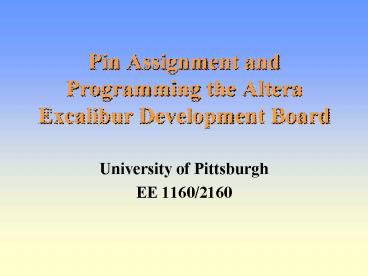Pin Assignment and Programming the Altera Excalibur Development Board - PowerPoint PPT Presentation
1 / 18
Title:
Pin Assignment and Programming the Altera Excalibur Development Board
Description:
Blocks and symbols can be design using only VHDL code. File - New - VHDL File - OK ... From pull-down menus select. Processing Start Programming ... – PowerPoint PPT presentation
Number of Views:211
Avg rating:3.0/5.0
Title: Pin Assignment and Programming the Altera Excalibur Development Board
1
Pin Assignment and Programming the Altera
Excalibur Development Board
- University of Pittsburgh
- EE 1160/2160
2
VHDL Files
- Blocks and symbols can be design using only VHDL
code - File -gt New -gt VHDL File -gt OK
3
VHDL File Editor Window
4
Completing VHDL File
- Save and Compile the file
- Create a new symbol by choosing
- File ? Create/Update ? Create Symbol Files for
Current File
5
Preliminary Steps
Create a New Project Complete a New Block
diagram Save and Compile the new design
6
Assign the Pins of Your Design to the Actual Pins
of Excalibur Board
- Use the Tables included to locate your particular
I/O with components on the Development Board. - Enter the Assignments in Quartus.
- Or edit the .qsf file associated with your
design.
7
Entering Assignments in Quartus
- Assignments ? Assign pins
- Select I/O name Select Pin Location
8
Entering Assignments in Quartus
- Save assignments after modification
9
Editing the .qsf File
- Open the .qsf File from your directory using
Notepad. - Add the new pin assignments into the file using
the following format - under the Pin and Location Assignments
header, use the format below to assign pins - set_location_assignment PIN_A2 to A
- set_location_assignment PIN_A3 to B
- set_location_assignment PIN_A4 to Q
- If the header is not shown, you can insert it
yourself. It is just a comment in the file. - After you modify and save the .qsf file, just
open the assignments editor and the new
assignments should appear in your design.
10
Verify the Device
- Go to Assignments -gt Device..
- Select Devices Pin Options
11
Device and Pin Options
- Select Unused Pins
- Reserve all unused pins as inputs, tri-stated
12
Recompile your Design
- (If your assignments are made correctly and your
design has no errors in it, this should go
smoothly, otherwise, fix all errors and compile
again)
13
Program the Excalibur Board with your Design
- Tools Menu? Programmer
14
Program the Excalibur Board with your Design
- Tools Menu? Programmer
- Verify Hardware ByteBlasterMV LPT1
- Verify proper design file with an .sof extension
15
Programming the Board cont.
- Select Program/Configure
- Click on Programming Icon on tool bar, or
- From pull-down menus select
- Processing ? Start Programming
16
Your Excalibur Board Will Then Be Programmed With
Your Design and If the Pin Assignments You Made
Are Correct, the Design You Made Should be Fully
Functional
- (If it is not, go back and double check you
assignments)
17
See the Attached Sheets for the Following
- Pin Assignments Table with all Peripherals on the
board, their name, and the Pin they are routed to
on the APEX Chip. - A Schematic of the Excalibur Development Board,
from Altera, with all peripherals and what they
are wired to.
18
For Lab Today
- Design and Implement a Decoder
- Use VHDL code in lab assignment
- Add decoder and clock divider to your cascaded
counter from Lab 1 - Compile the new design
- Do pin assignments as prescribed in this
presentation - Show the Lab TAs the functioning circuit on the
Excalibur Board - Do Your Write-up including the fact that it
worked in the Physical World!































